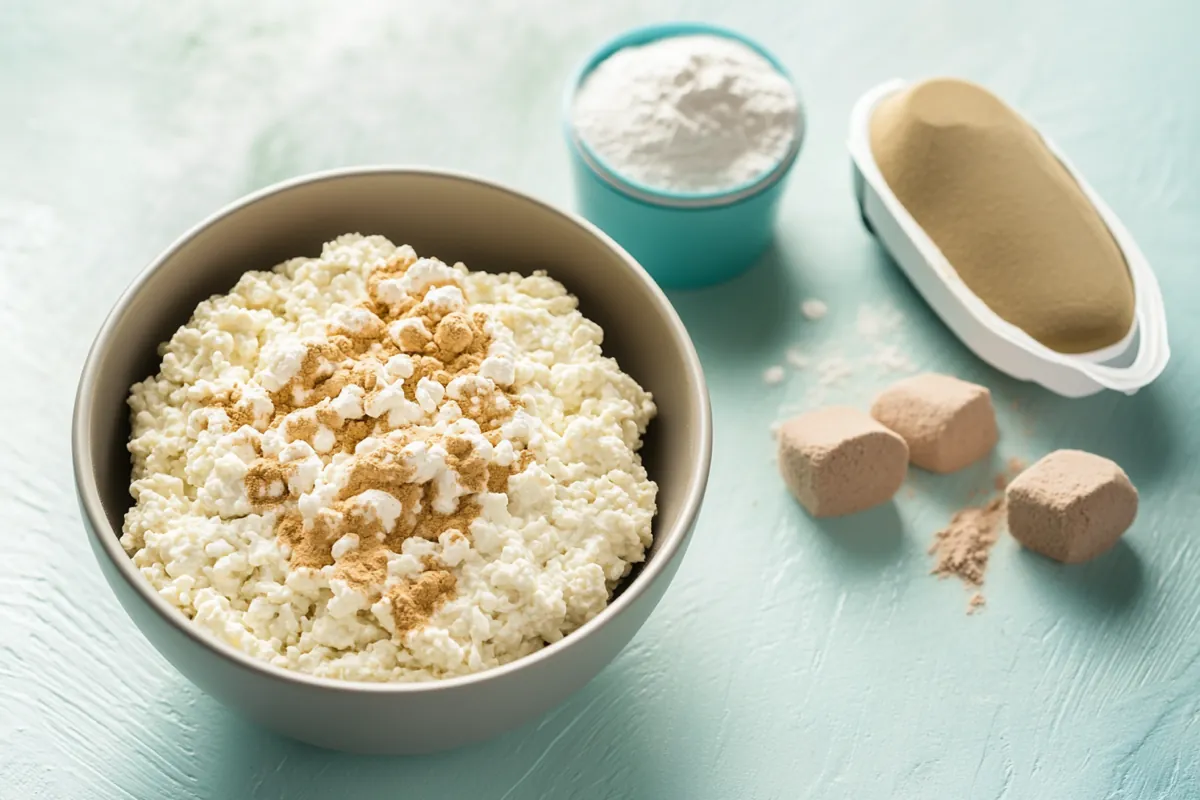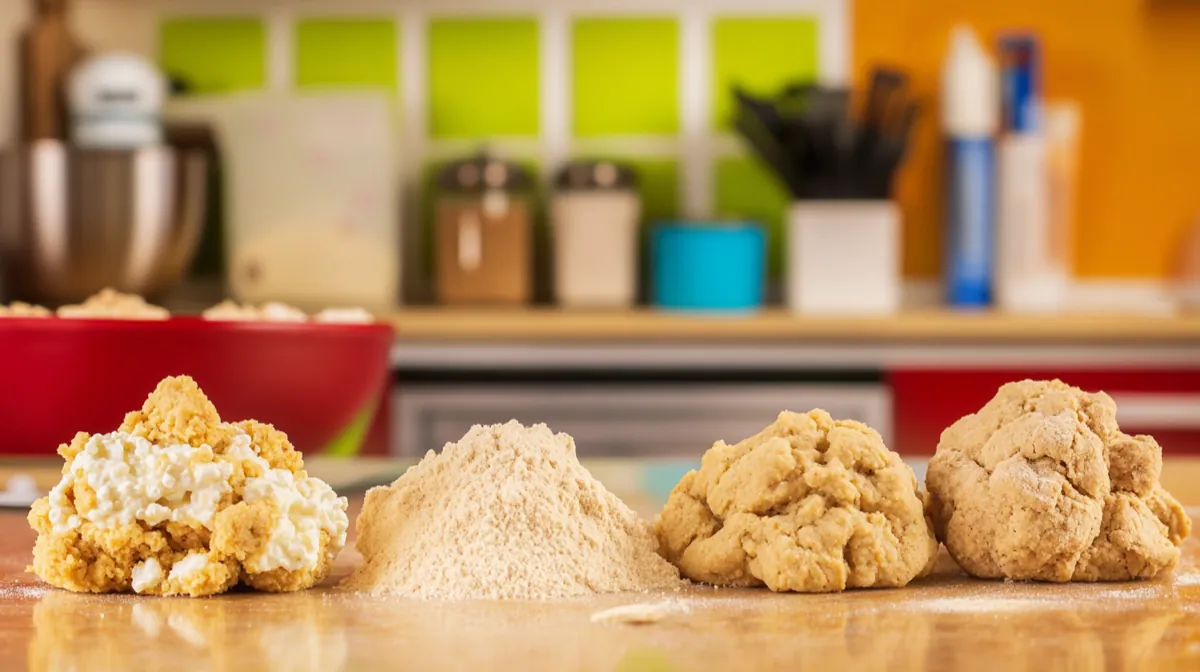Baking can sometimes feel like a science experiment, especially when it comes to troubleshooting cottage cheese cookie dough. This unique ingredient can create deliciously moist cookies, but it can also lead to frustration if things don’t go as planned. In this article, we will explore the benefits of using cottage cheese, common issues you may encounter, and how to fix them. By the end, you’ll be well-equipped to create perfect cookies every time.
Table of Contents
Introduction to Cottage Cheese Cookie Dough
Cottage cheese is a nutritious and versatile ingredient that adds moisture and protein to your baking. It’s not just for savory dishes anymore! Many people are discovering the delightful texture and flavor that cottage cheese can bring to cookie dough.
Benefits of Using Cottage Cheese in Cookie Dough
Using cottage cheese in cookie dough has several benefits that make it a great choice for health-conscious bakers.
Nutritional Advantages
Cottage cheese is rich in protein and lower in fat compared to conventional cookie ingredients. This makes it a fantastic option for those looking to enjoy treats without the guilt. By incorporating cottage cheese, you can elevate the nutritional profile of your cookies, making them a more wholesome snack. For more ideas on using cottage cheese, check out our ultimate guide to cottage cheese.
Texture and Flavor Enhancements
Cottage cheese lends a unique texture to cookie dough. It helps create a moist and chewy cookie, which is often preferred over the dry and crumbly texture that can come from traditional recipes. Moreover, it adds a subtle tanginess that can complement sweet ingredients beautifully.
Common Issues in Cottage Cheese Cookie Dough
Despite its many benefits, working with cottage cheese cookie dough can sometimes lead to problems. Here are some common issues you might face.
Why is My Cookie Dough Not Forming?
One of the most frustrating issues is when your cookie dough simply won’t come together. This could be due to several factors, including the consistency of the cottage cheese or not enough binding ingredients. If your dough feels too crumbly, consider adding a bit more liquid or fat to help it bind.
Why is My Cookie Dough Not Coming Together?
If your dough is not coming together, check if you’re using the right ratios of ingredients. Cottage cheese can vary in moisture content, so measuring accurately is key. Additionally, mixing thoroughly can help ensure that all ingredients are well incorporated, preventing any dry spots in your dough.
In the next sections, we will dive deeper into troubleshooting specific types of cottage cheese cookie dough, including variations made with regular flour, oat flour, and protein powder. Understanding how each ingredient affects your cookie dough will empower you to adjust your recipes confidently and achieve delicious results.

Troubleshooting Cottage Cheese Cookie Dough with Regular Flour
When using regular flour in your cottage cheese cookie dough, it’s essential to understand how the ingredients interact. Regular flour can create a structure that holds the cookies together, but it can also lead to common issues if not measured or mixed correctly.
Key Ingredients and Their Roles
Understanding the role of each ingredient can help you troubleshoot effectively.
The Role of Cottage Cheese
Cottage cheese not only adds moisture but also provides protein, making your cookies more satisfying. However, if your cottage cheese is too watery, it can lead to overly sticky dough, making it difficult to work with.
Understanding Regular Flour
Regular flour is a staple in many cookie recipes. It provides the structure needed for cookies to hold their shape. If too much flour is added, you might end up with dry cookies. On the other hand, if too little flour is used, your cookies may spread too much during baking.
Common Problems and Solutions
Several issues can arise when making cottage cheese cookie dough with regular flour.
Troubleshooting Cottage Cheese Cookie Dough with Regular Flour
When using regular flour in your cottage cheese cookie dough, it’s essential to understand how the ingredients interact. Regular flour can create a structure that holds the cookies together, but it can also lead to common issues if not measured or mixed correctly.
Key Ingredients and Their Roles
Understanding the role of each ingredient can help you troubleshoot effectively.
The Role of Cottage Cheese
Cottage cheese not only adds moisture but also provides protein, making your cookies more satisfying. Additionally, it enhances the nutritional profile of your treats. However, if your cottage cheese is too watery, it can lead to overly sticky dough, making it difficult to work with. To avoid this, opt for a thicker variety or drain excess liquid before mixing.
Understanding Regular Flour
Regular flour is a staple in many cookie recipes. It provides the structure needed for cookies to hold their shape. If too much flour is added, you might end up with dry cookies. On the other hand, if too little flour is used, your cookies may spread too much during baking. The ideal balance is crucial for achieving the perfect texture.
Common Problems and Solutions
Several issues can arise when making cottage cheese cookie dough with regular flour. Here are some common problems and how to solve them.
Dough Too Sticky or Wet
If your cookie dough is too sticky, it can be a hassle to work with. This often happens when too much cottage cheese is added or if the dough isn’t chilled properly. To fix this issue:
- Add more flour: Gradually incorporate small amounts of flour until the dough reaches the desired consistency.
- Chill the dough: Refrigerate the dough for at least 30 minutes. This will help firm it up, making it easier to handle.
Dough Too Dry and Crumbly
On the other hand, if your dough is too dry and crumbly, it can be challenging to form into cookies. This problem may arise if there’s not enough moisture from the cottage cheese or if too much flour is used. Here’s how to remedy this:
- Add liquid: Mix in a little milk or water, one tablespoon at a time, until the dough comes together.
- Incorporate more cottage cheese: If the dough is dry, try adding a bit more cottage cheese to boost the moisture.
Tips for Perfecting Regular Flour Cookie Dough
To ensure your cottage cheese cookie dough with regular flour turns out perfectly, consider these tips:
- Measure accurately: Use a kitchen scale for precise measurements. This can help prevent issues related to ingredient ratios.
- Mix thoroughly: Make sure all ingredients are well combined. This prevents dry patches that can lead to uneven texture in your cookies.
- Experiment with chilling: Chilling the dough not only improves texture but also enhances flavor. It allows the ingredients to meld together, resulting in better-tasting cookies.
Incorporating these tips can significantly improve your baking experience and lead to delicious results. For more insights on using cottage cheese in various recipes, explore our ultimate guide to cottage cheese.

Troubleshooting Cottage Cheese Cookie Dough with Oat Flour
Oat flour is becoming increasingly popular in baking, especially for those seeking gluten-free alternatives. Using oat flour in your cottage cheese cookie dough can yield delightful results, but it also comes with its own set of challenges.
Why Choose Oat Flour?
Oat flour is made from ground oats and is known for its mild flavor and health benefits. It is rich in fiber, which can enhance the texture of your cookies. Additionally, oat flour tends to absorb more moisture than regular flour, making it essential to adjust your recipe accordingly.
Health Benefits of Oat Flour
- High in Nutrients: Oat flour is packed with vitamins, minerals, and antioxidants.
- Promotes Satiety: The fiber content helps keep you full longer, making your cookies more satisfying.
- Gluten-Free: For those with gluten sensitivities, oat flour offers a safe alternative that still provides excellent texture.
Common Issues with Oat Flour Cookie Dough
Working with oat flour can lead to some unique problems. Here are a few common issues you may encounter and how to resolve them.
Why Does My Cookie Dough Keep Separating?
If your dough keeps
Troubleshooting Cottage Cheese Cookie Dough with Oat Flour
Oat flour is becoming increasingly popular in baking, especially for those seeking gluten-free alternatives. Using oat flour in your cottage cheese cookie dough can yield delightful results, but it also comes with its own set of challenges.
Why Choose Oat Flour?
Oat flour is made from ground oats and is known for its mild flavor and health benefits. It is rich in fiber, which can enhance the texture of your cookies. Additionally, oat flour tends to absorb more moisture than regular flour, making it essential to adjust your recipe accordingly.
Health Benefits of Oat Flour
- High in Nutrients: Oat flour is packed with vitamins, minerals, and antioxidants.
- Promotes Satiety: The fiber content helps keep you full longer, making your cookies more satisfying.
- Gluten-Free: For those with gluten sensitivities, oat flour offers a safe alternative that still provides excellent texture.
Common Issues with Oat Flour Cookie Dough
Working with oat flour can lead to some unique problems. Here are a few common issues you may encounter and how to resolve them.
Why Does My Cookie Dough Keep Separating?
If your dough keeps separating, it may be due to the absorbent nature of oat flour. When too much flour is used, it can lead to a dry dough that doesn’t hold together. To fix this issue:
- Add more moisture: Incorporate a little more cottage cheese or a splash of milk to help bind the ingredients together.
- Mix thoroughly: Ensure that all ingredients are well combined. This can help the flour absorb moisture more evenly.
Why is My Cookie Dough Still Gooey?
A gooey cookie dough can be frustrating, especially when you’re trying to shape it. This often happens because oat flour requires more liquid than regular flour. To tackle this problem:
- Refrigerate the dough: Chilling the dough for about 30 minutes can help firm it up, making it easier to handle.
- Incorporate more flour: If the dough remains too wet after chilling, gradually add oat flour until you achieve the desired consistency.
Tips for Enhancing Oat Flour Cookie Dough
To create the best cottage cheese cookie dough with oat flour, keep these tips in mind:
- Balance the ingredients: Since oat flour absorbs more moisture, adjusting the ratio of cottage cheese and other wet ingredients will lead to better results.
- Experiment with flavors: Oat flour has a mild flavor, so consider adding spices or extracts such as cinnamon or vanilla to enhance the taste.
- Add mix-ins: Incorporate chocolate chips, nuts, or dried fruit to elevate your cookie experience. These additions can bring out the flavors and add texture.
By following these guidelines, you can overcome common challenges when working with oat flour in your cookie dough. For further details on how to utilize oat flour effectively, check out our cottage cheese baking substitutions guide.

Troubleshooting Cottage Cheese Cookie Dough with Protein Powder
Adding protein powder to your cottage cheese cookie dough can enhance its nutritional profile, making it a great choice for post-workout snacks. However, it can also lead to some specific challenges in the baking process.
Benefits of Adding Protein Powder
Incorporating protein powder into your cookie dough has several advantages:
- Increased Protein Content: This makes your cookies more filling and can support muscle recovery.
- Flavor Variety: Protein powders come in various flavors, allowing you to customize the taste of your cookies.
- Texture Enhancement: When used correctly, protein powder can improve the texture of cookies, leading to a delightful chewiness.
Impact on Texture and Nutrition
While protein powder can enhance the nutritional value of your cookies, it can also affect the texture. Too much protein powder can make the dough dry or crumbly, while too little can lead to a gooey consistency. Therefore, finding the right balance is crucial.
Common Problems with Protein Powder Cookie Dough
Here are some issues you might encounter when using protein powder in your cottage cheese cookie dough, along with solutions.
Adjusting for Consistency
If your cookie dough is too dry after adding protein powder, it may have absorbed too much moisture. To remedy this:
- Add liquid: Incorporate a little more cottage cheese or a splash of milk to help bind the ingredients together.
- Mix thoroughly: Make sure all ingredients are well combined, which can help distribute moisture evenly throughout the dough.
Flavor Balance and Enhancements
Sometimes, cookie dough can taste overly “protein-y,” especially if you use a flavored protein powder. If you find that the flavor is not to your liking:
- Add vanilla extract: A teaspoon of vanilla can help mask any overpowering protein flavor.
- Include spices: Cinnamon, nutmeg, or cocoa powder can enhance the overall flavor of your cookies and make them more enjoyable.
Conclusion: Mastering Cottage Cheese Cookie Dough
Incorporating cottage cheese into your cookie dough opens up a world of possibilities. While troubleshooting may arise, understanding the nuances of different flours and additives can significantly enhance your baking experience. By following the tips and solutions outlined in this article, you’ll be well on your way to mastering the art of cottage cheese cookie dough. Enjoy experimenting with different ingredients and flavors to create your perfect cookie!
FAQ
When it comes to troubleshooting cottage cheese cookie dough, many bakers have similar questions. Here are some common inquiries and their answers.
Why is My Cookie Dough Not Forming?
If your cookie dough isn’t coming together, it might be due to a lack of binding ingredients. Ensure you’re using enough cottage cheese and consider adding a bit more liquid to help the mixture combine.
Why is My Cookie Dough Not Coming Together?
Inconsistent ingredient ratios can cause this issue. Make sure you measure your ingredients accurately. If it’s still crumbly, try mixing longer to ensure everything is combined.
Why is My Cookie Dough Still Gooey?
A gooey dough often indicates excess moisture. Refrigerating the dough can help, or you can gradually add more flour or protein powder until the desired consistency is reached.
Why Does My Cookie Dough Keep Separating?
If your dough keeps separating, it may be due to the absorbent nature of oat or protein flour. Adding more wet ingredients or mixing thoroughly can help resolve this issue.




